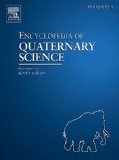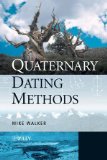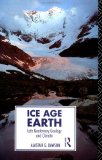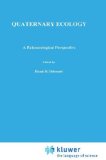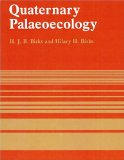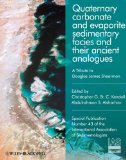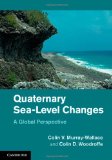|
Encyclopedia of Quaternary Science
The quaternary sciences constitute a dynamic, multidisciplinary field of research that has been growing in scientific and societal importance in recent years. This branch of the Earth sciences links ancient prehistory to modern environments. Quaternary terrestrial sediments contain the fossil remains of existing species of flora and fauna, and their immediate predecessors. Quaternary science plays an integral part in such important issues for modern society as groundwater resources and contamination, sea level change, geologic hazards (earthquakes, volcanic eruptions, tsunamis), and soil erosion. With over 360 articles and 2,600 pages, many in full-color, the Encyclopedia of Quaternary Science provides broad ranging, up-to-date articles on all of the major topics in the field. Written by a team of leading experts and under the guidance of an international editorial board, the articles are at a level that allows undergraduate students to understand the material, while providing active researchers with the latest information in the field. |

|
Quaternary Glaciations - Extent and Chronology
The book presents an up-to-date, detailed overview of the Quaternary glaciations all over the world, not only with regard to stratigraphy but also with regard to major glacial landforms and the extent of the respective ice sheets. The locations of key sites are included. The information is presented in digital, uniformly prepared maps which can be used in a Geographical Information System (GIS) such as ArcView or ArcGIS. The accompanying text supplies the information on how the data were obtained (geomorphology, geological mapping, air photograph evaluation, satellite imagery), how the features were dated (14C, TL, relative stratigraphy) and how reliable they are supposed to be. All references to the underlying basic publications are included. Where controversial interpretations are possible e.g. in Siberia or Tibet, this is pointed out. As a result, the information on Quaternary glaciations worldwide will be much improved and supplied in a uniform digital format. The information on the glacial limits is compiled in digital form by the coordinators of the project, and is available to the readers in the form of CD-ROMs, which are included with the book. |
|
Global Environments Through the Quaternary: Exploring Environmental Change
This concise modern survey examines the many recent interdisciplinary developments in the study of environmental changes over the last three million years. It is the fourth edition of this acclaimed book and has been completely revised to reflect the substantial amount of new information and to provide an up-to-date analysis of this important and politicized topic. The outline of the book remains the same, with the new material incorporated throughout. The most heavily revised sections are those on techniques for environmental reconstruction, glaciation in lower altitudes and the southern hemisphere, climatic changes in the twentieth century, and the causes of environmental change. These sections include numerous new illustrations and new guides to further reading. The broad geographical coverage and non-technical language make this book valuable to students in a wide range of courses in geology, physical geography, archaeology, and the life sciences. |
|
Quaternary Dating Methods
This introductory textbook introduces the basics of dating, the range of techniques available and the strengths and limitations of each of the principal methods. Coverage includes: the concept of time in Quaternary Science and related fields the history of dating from lithostratigraphy and biostratigraphy the development and application of radiometric methods different methods in dating: radiometric dating, incremental dating, relative dating and age equivalence Presented in a clear and straightforward manner with the minimum of technical detail, this text is a great introduction for both students and practitioners in the Earth, Environmental and Archaeological Sciences. |
|
Ice Age Earth: Late Quaternary Geology and Climate
Ice Age Earth provides the first detailed review of global environmental change in the Late Quaternary. Significant geological and climatic events are analysed within a review of glacial and periglacial history. The melting history of the last ice sheets reveals that complex, dynamic and catastrophic change occurred, change which affected the circulation of the atmosphere and oceans and the stability of the Earth's crust. |
|
Quaternary Ecology: A paleoecological perspective
The increasing interest during recent years in vegetation history, long-term climatic changes and the development of biotic communities has resulted in a growth of the literature in this field and has provided an incentive for scientists to use palaeo-ecology concepts to clarify contemporary ecological issues. Quaternary ecology offers the perspective of time, in using "natural experiments of the past" to evaluate the responses of population, communities and ecosystems to climatic and environmental changes on a time scale extending back over the past two million years of the quaternary period. Examples from the palaeo-ecological literature demonstrate how quaternary ecology interfaces with other branches of ecology, including plant demography, ecological genetics, limnology and landscape ecology. The book provides an integrated overview of this interdisciplinary area. The authors examine the validity of space for time substitution in studies of plant succession, the individualistic nature of species migrations and invasions of pre-existing communities, the disassembly and reassembly of communities following major environmental change and the applications of quaternary ecology to predicting biotic responses to future global climatic change. By examining key ecological issues and controversies that can be approached fruitfully using palaeo-ecological methods, this book is intended to complement rather than replace traditional textbooks in ecology and palaeo-ecology. |
|
Quaternary Palaeoecology
Quaternary Palaeoecology, first published in 1980, discusses the methods and approaches by which Quaternary environments can be reconstructed from the fossil and sedimentary record. This knowledge is of great value as the Quaternary was a time of rapid ecological change, culminating in the present pattern and diversity of ecosystems. It is possible not only to relate these changes to fluctuating climates but also to infer what Man's early influence may have been. The authors describe how past flora and fauna can be reconstructed and how the numbers of fossils can be used to reconstruct past plant and animal populations and communities, and past environments. John Birks has researched in a variety of fields within Quaternary palaeoecology, including pollen analysis and vegetation history, environmental change, past climate reconstruction, and palaeolimnology. Since the 1980s he has introduced and developed numerical methods and quantitative approaches into palaeoecology and palaeolimnology. Besides research in Norway and the UK, he has also worked on palaeoecological problems in Svalbard, Sweden, Finland, Switzerland, Minnesota, and the Yukon. He serves on the editorial boards of several journals and has published widely on many aspects of Quaternary palaeoecology. He is currently Professor of Quantitative Palaeoecology at the University of Bergen, Norway, and University College London, UK. Hilary Birks researches on palaeoecology and past climates primarily through the use of plant macrofossil analysis. She took up the study of plant macrofossils in Minnesota, USA in 1970, where she investigated the modern representation of plants in lake sediments by their fruits and seeds, and also worked on the palaeolimnological record of recent eutrophication and late-glacial palaeoecology. Since then she has extended her macrofossil studies to the late-glacial of Scotland and western Norway, the full-glacial of Beringia (Alaska) and recent changes in North African lakes brought about by human activities. She is Professor of Palaeoecology at the University of Bergen, Norway and teaches palaeoecology at the University of Bergen and University College London, UK. |
|
Quaternary Climates, Environments and Magnetism
The Quaternary has been a period of major climatic and environmental oscillations, and our knowledge of these past variations is important for our understanding of the possible impact of human activity on the present-day environment. Quaternary Climates, Environments and Magnetism presents an up-to-date account of the rich variety of uses of magnetic measurements in the environmental geosciences. Ten chapters by leading world authorities describe the highlights of environmental magnetic work during the past decade and identify directions for future research. This comprehensive and multidisciplinary coverage leads to a more thorough understanding of the environmental processes involved. This volume will be of interest to research scientists from a wide range of disciplines working on Quaternary environments, including earth and environmental sciences, physical geology, geography, and palaeoclimatology. It will also be valuable as a supplementary text for graduates and advanced undergraduates. |
|
Quaternary carbonate and evaporite sedimentary facies and their ancient analogues
This volume commemorates the eclectic research of Douglas James Shearman into evaporites, which was initiated by his studies of the prograding UAE coastal sabkhas or salt flats that incorporate evaporite minerals which displace and replace earlier carbonate sediments. His subsequent proselytization of the study of ancient evaporites in sedimentary sections all over the world led to fundamental advances in our understanding of arid zone carbonate sedimentology. The papers presented here are based on presentations made in Abu Dhabi, UAE 12-14th October 2004 and 7th –8th November 2006. They provide a retrospective from the 1960's and 70's of Holocene evaporites and carbonates, recapturing Shearman's contribution by revisiting the Holocene coastal evaporite and carbonate sediments of the Arabian/Persian Gulf from Abu Dhabi, Qatar, and Oman. The first set of papers considers these sediments from the perspective of their coastal geomorphology, sedimentary character and their geochemistry. Later papers examine the significance of these settings in the ancient geological section world-wide, including examples from the Mesozoic-Cenozoic of the Moroccan Atlantic margin and the Upper Jurassic Arab Formation of the Arabian Gulf. |
|
Quaternary Sea-Level Changes: A Global Perspective
There have been significant changes in sea level over the past two million years, and a complete understanding of natural cycles of change as well as anthropogenic effects is imperative for future global development. This book reviews the history of research into these sea-level changes and summarises the methods and analytical approaches used to interpret evidence for sea-level changes. It provides an overview of changing climates during the Quaternary, examines processes responsible for global variability of sea-level records, and presents detailed reviews of sea-level changes for the Pleistocene and Holocene. The book concludes by discussing current trends in sea levels and likely future sea-level changes. This is an important and authoritative resource for academic researchers and graduate and advanced undergraduate students working in tectonics, stratigraphy, geomorphology, physical geography, environmental science and other aspects of Quaternary studies. |















